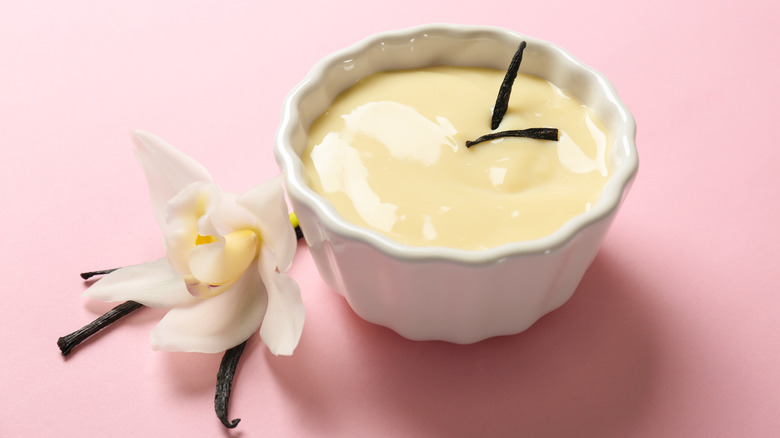What's The Difference Between Custard And Pudding?
Think of all the ways to eat pudding. You can eat it by itself or as a layer in a cake or ice cream parfait, complete with fruit, cookie crumbs, and other sweet ingredients. It can also be eaten as a savory dish, like Yorkshire pudding. Then you have pudding's cousin, custard, which is commonly used as the base in sweet desserts like leche flan and crème brûlée, and in savory foods like quiches. Like ice cream and yogurt, it can also be eaten as a frozen dessert as well.
Custard and pudding share a number of similarities. They're both sweet, used in various desserts, and have a similar consistency. With its creamy texture, custard can have an almost identical appearance to pudding. It can be hard to tell the difference, but these mixtures do have some distinct differences, and the biggest one lies in the ingredients.
What exactly is in custard, and how do you make it?
Custard is a mixture that's made using eggs, milk, sugar, and flavorings. The inclusion of eggs or egg yolks is the main difference between custard and pudding, which acts as the primary thickening agent in custard (via Britannica). Sometimes corn starch, flour, or gelatin is added to custard in certain recipes for an even thicker consistency.
Adding those aforementioned ingredients will give you different consistency variations. For example, adding cornstarch will give you pastry cream while adding gelatin will give you crème anglaise. And if you add fine granulated sugar and flour (or any other starch) to the base custard ingredients, you'll have what's called confectioner's custard.
As for the cooking process, custard can be cooked in a number of different ways, including in a double boiler, stovetop saucepan, or pressure cooker. You can also bake it in the oven, but it's best to use a water bath with this method to help it bake evenly. Whichever method you choose, the cooking process in general is more delicate than that of pudding, due to the egg coagulation process.
What exactly is in pudding, and how do you make it?
Comparable to custard, pudding is made with milk or cream, but it usually doesn't include eggs to thicken it. Cornstarch or flour are typically used as thickening agents instead (via Britannica). This combination of ingredients gives pudding a lighter consistency than custard.
In terms of consistency variations, pudding doesn't offer as many as custard. However, pudding can also be eaten as a sweet dessert or savory item. Plus, there are dozens of different types of pudding, including bread pudding, rice pudding, and Christmas figgy pudding.
When it comes to making pudding, you can opt for the instant boxed variety or make it from scratch on the stovetop. Regardless of which option you choose, you don't have to think about egg coagulation with pudding, making the overall preparation process a bit more convenient than that of custard.
There are several differences between custard and pudding, but the main differentiating factor is the presence of eggs.


